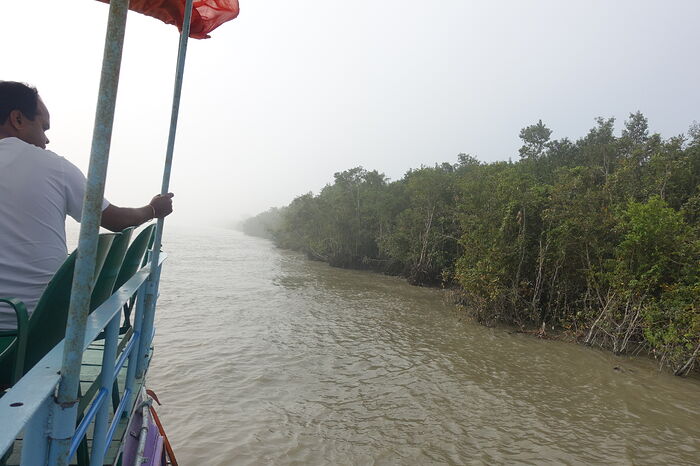Breakfasts in Bangladesh tend to differ only a little from other meals, with main staples of either “ruti” (flatbread), “porota” (pan-fried flatbread) or rice, accompanied by a “dal” (yellow lentil) curry, chicken “dopiaza” (chicken in an onion-rich, spicy gravy) and fried eggs.
The following are some breakfast spots in the various towns we traversed during our journey through Bangladesh:
- Ornate Hotel @ Dhaka. Old Town Dhaka is the colourful part of this often-times chaotic capital city of 14 million-plus inhabitants. Ornate Hotel is located in a “quieter” part of the old city, and provides a respite from the incessant honking typical of South Asian roads.
Ornate Hotel has a substantial breakfast spread which offers not only a choice of “ruti” and “porota”, but also spiced “kichuri” rice cooked with yellow lentils, which lent the dish an earthy flavour. A tasty chicken “dopiaza” provides the protein and gravy to dip the breads in. The curried eggs were a delight.
Dhaka’s streets are teeming with all sorts of vehicles - some of which we really didn’t expect to see:
- Momo Inn @ Bogra.
This is a new and pretty lavish hotel - the breakfast spread is largely vegetarian: large yellow lentils, cooked to a thick consistency, were absolutely scrumptious. There was also “sobji bhazi” - lightly spiced, cubed squash, carrots, potatoes and green papaya. A choice of “ruti” and “porota” to mop up the gravy. There was also “dudh sewaian” - a very tasty Bengali sweet of fine vermicelli noodles in milk & palm sugar.
Bogra is a jumping off point to see the archaeological sites of Govinda Vita. But it’s also near Sirajgong, a village where traditional weaving is a cottage industry:
- Hotel Nice @ Rajshahi.
Breakfast here consisted of deep-fried “puris”, dipped into spicy “dal” gravy, with fried eggs done to order.
Rajshahi is our overnight stopping point between Sompura Vihara, the medieval ruins of what was the largest Buddhist monastery south of the Himalayas, and Kushtia, to visit the historic Rajbari (King’s Palace). Rajshahi is also where one can catch the spectacular sunset over the River Ganges.
Street vendors lined the Esplanade to watch the sunset- a major activity in this town, but our tour guide warned us against trying the street food here due to concerns over the hygiene.
- Hotel Kheya @ Kushtia.
The breakfast spread here was pretty standard: “ruti” with “dal” (yellow lentil curry), a mixed vegetable “sobji” and fried eggs to order.
Kushtia is a major tourist town for local Bangladeshi visitors for two reasons: (1) the shrine of Lalon Shah, a major Bengali folk singer and spiritual leader, whose followers would break out into singing and dancing in homage to him; and (2) Kuthibari, the well-preserved home of Rabindranath Tagore, Bengal’s foremost writer-poet and the 1913 Nobel Prize laureate for Literature.
Older Bangladeshi men, like these two keepers at Kuthibari (Tagore’s manor) liked to dye their beards orange using henna (following in the footsteps of the Prophet Mohammed, as Bangladeshis are largely Sunni-Muslims). I thought it made them look like dark-skinned Irish leprechauns.
- Parjatan Hotel @ Mongla.
Mongla is a tiny, dusty frontier town on the edge of the Sundarbans, the world’s largest mangrove swamps. We stopped here for an overnighter before catching a cruise-boat that’ll take us into the mangrove swamps where Bengal tigers, crocodiles and various fauna live.
Breakfast at the crumbling Parjatan Hotel, the only place for visitors to stay here, consisted of pan-fried “porotas”, dry griddle-cooked “rutis”, a watery lentil curry, “sobji bazi” (spiced green papayas) and fried eggs.
The pier outside Parjatan Hotel is full of small wooden skiffs manned by standing oarsmen which would ferry passengers to the other side of the river where larger boats, including the one taking us into the Sundarbans are berthed.
Cruise up the Sundarbans:
- City Inn @ Khulna.
Khulna seemed positively “civilised” after the mosquito-infested Mongla at the Sundarbans. City Inn is a delightful hotel on a busy street full of retail shops and local eateries.
City Inn’s breakfast spread included deep-fried, puffy “puris”, griddle-cooked “rutis”, “dal”, mixed greens “sobji”, a hearty “nihari” and fried eggs cooked to order.
From Khulna, we sallied forth to Bagerhat, the medieval “City of Mosques”, and from there to Hularhat to catch the paddle-wheel steamship that is to take us on a 16-hour cruise upriver back to Dhaka.
- Al-Razzak @ Old Dhaka.
Old Dhaka greeted us at the end of the 16-hour cruise upriver. Its old port and waterways are heaving with people and all manner of watercrafts. Our breakfast was at Al-Razzak, one of the oldest and best-known eateries in the Old Town quarter.
We had “ruti” with “nihari”, “kacchi biriyani” cooked with mutton, and chicken “biriyani”.
Overall, breakfasts in Bangladesh tend to be carb-heavy, substantial meals. We sometimes skipped lunch here as we tried to maximise the time we had to sightsee and explore more places along the way. Roads are really, really bad here, so one has to factor that in.


























